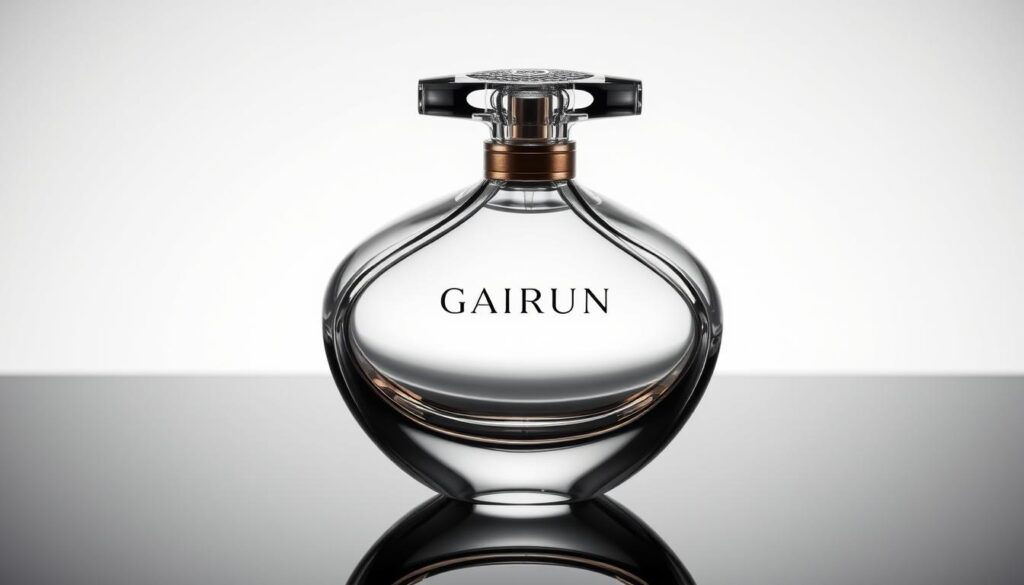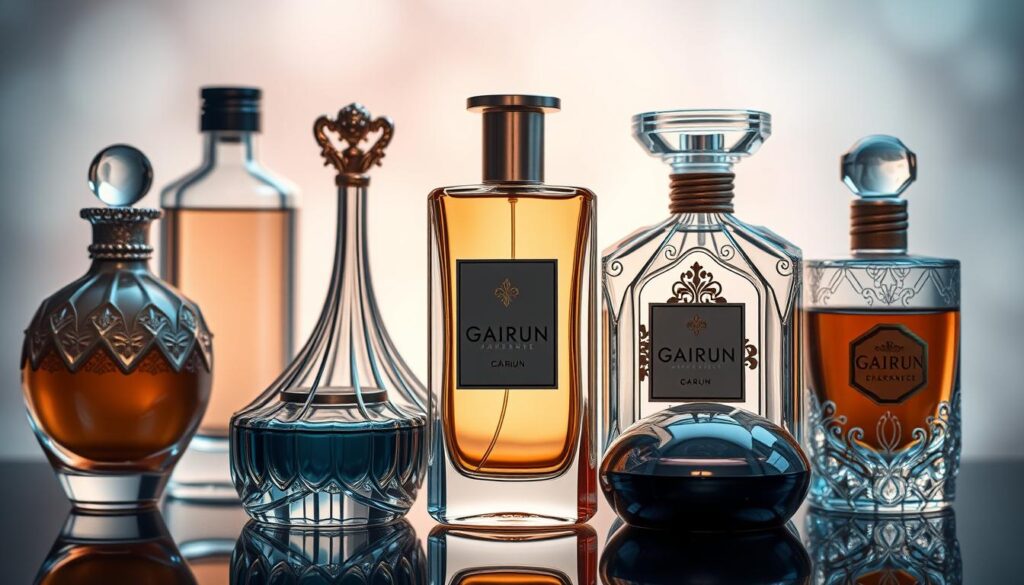Perfume bottles are more than just containers for scents. They are also pieces of art that show off personal style and brand identity. Looking into the parts of a perfume bottle shows how design and function work together. Each part is important for a better fragrance experience.
Knowing how a perfume bottle is made helps us see the beauty in its creation. From the fancy cap to the strong base, every part is made with care. This guide will take you through the different parts that make up these beautiful bottles.
Key Takeaways
- Perfume bottles go beyond mere containers, serving as artistic expressions and symbols of style.
- Each part of a perfume bottle, from cap to base, plays a vital role in its design and function.
- Understanding bottle anatomy enhances our appreciation for the craftsmanship behind fragrance bottles.
- Details in design ensure that perfume bottles are both beautiful and functional.
- This guide aims to provide a detailed look at each component involved in perfume bottle design.
Introduction to Perfume Bottle Anatomy
The perfume bottle anatomy is key to fragrance design. Knowing the perfume bottle parts names helps us value their craftsmanship. It’s like a puzzle with each piece playing a special role.
A perfume bottle has many parts, each important for its look and how it works. These include the bottle cap, sprayer, primary and secondary caps, the bottle body, neck, shoulder, base, and internal seal.
The bottle cap keeps the perfume safe and looks good. The sprayer mechanism spreads the scent evenly. The primary cap and secondary cap seal the bottle tightly to protect the perfume.
The body is the main part of the bottle, showing off the brand and holding the fragrance. The neck and shoulder add to the bottle’s look and how it works.
The bottle base keeps the bottle steady, and the internal seal keeps the scent fresh. These parts show how art and engineering come together in perfume bottles.
Learning about the perfume bottle anatomy shows us how beautiful and thoughtful these containers are. It reveals the care put into designing and making them.
Bottle Cap Components and Their Functions
Perfume bottle components are carefully made to be both useful and good-looking. The bottle cap parts are key to keeping the perfume fresh and easy to use. Each piece, from the main cap to the spray mechanism, has its own job.
Primary Cap
The main cap is a big part of the bottle, showing off the brand’s style. It makes the bottle look better and keeps it from spilling. You can find these caps in metal, plastic, or a mix of materials, making them strong and feeling high-quality.
GAIRUN is a perfume bottle caps manufacturer , mainly made of metal materials, such as zinc alloy, copper, aluminum, etc
Secondary Cap
The secondary cap is crucial for extra protection. It sits under the main cap, keeping the seal tight and the fragrance fresh by stopping it from evaporating. This part is made to work well with the perfume, avoiding any bad reactions.
Sprayer Mechanism
The spray mechanism is at the core of the perfume bottle. It’s designed to spray the fragrance evenly and perfectly. It has parts like a pump and a nozzle that work together to get the perfume out right. Knowing how it works shows the careful design behind each spray.
| Component | Material | Function |
|---|---|---|
| Primary Cap | Metal/Plastic/Composite | Visual appeal & security |
| Secondary Cap | Compatible material with fragrance | Additional protection & seal integrity |
| Sprayer Mechanism | Plastic & Metal | Fine mist dispersion |
Main Body and Its Structural Design
The main body of a perfume bottle is key in showing off the brand’s style. It’s often the first thing that grabs a potential buyer’s attention. It tells a lot even before they smell the scent.
Perfume bottles come in many shapes and styles. Designers use the shape to show what the fragrance is like inside. For example, Nina Ricci’s bottle looks like an apple, while Chanel’s No. 5 has simple, modern lines.

The design of the bottle isn’t just for looks; it’s also practical. A good design makes the bottle easy to use, strong, and lets you see the liquid inside. This makes it more appealing to look at. Brands like Dior and Marc Jacobs use this to create a memorable experience for buyers.
The main body of a perfume bottle is like a blank canvas for creativity. It lets designers use their imagination with shapes and details. This makes each fragrance stand out.
Perfume Bottle Materials: Choices and Implications

The materials used for perfume bottle components are crucial. They affect how the bottle looks and works. Glass, plastic, and metal are the top choices. Each has its own strengths, like durability, weight, and how it affects the environment.
Glass is a favorite for luxury brands because it lets you see the perfume inside. It keeps the scent fresh for a long time. But, it’s heavy and can break easily, which might make it hard to carry around.
Plastic is great for budget-friendly perfumes. It’s light and strong, making it easy to take on the go. But, it might not keep the perfume’s scent as well as other materials.
Metal adds a touch of elegance to perfume bottles. Aluminum is a good choice because it’s both light and strong. It looks good and is practical to use.
The table below shows the main features of these perfume bottle materials:
| Material | Durability | Weight | Transparency | Environmental Impact |
|---|---|---|---|---|
| Glass | High | Heavy | High | Recyclable |
| Plastic | Moderate | Light | Variable | Less environmentally friendly |
| Metal | High | Light to Moderate | None | Recyclable |
In conclusion, picking the right fragrance bottle parts matters a lot. It affects the bottle’s look, use, and how green it is. This choice shapes how people see and enjoy the perfume.
Detailed Look at the Parts of a Perfume Bottle
The anatomy of a perfume bottle is intricate and vital. It keeps the bottle functional and elegant. We’ll explore the specific parts of a perfume bottle. Each part plays a key role in the bottle’s structure and function.
Neck and Shoulder
The neck and shoulder are crucial to a perfume bottle. The neck connects the bottle to the sprayer, ensuring a tight fit and no leaks. The shoulder adds strength and beauty. Together, they make the bottle look elegant and work well.
Bottle Base
The base keeps the perfume bottle stable. It carries the bottle’s weight and keeps it upright. It’s thick and strong, making it a key part of the bottle’s structure.
A good base design boosts durability and looks. It’s essential for the bottle’s beauty and function.
Internal Seal
The internal seal stops leaks and keeps the fragrance fresh. It’s inside the neck, making sure the perfume stays inside. This part is key to keeping the scent good and lasting longer.
| Part | Function | Importance |
|---|---|---|
| Neck and Shoulder | Connects with sprayer, adds structural strength | Prevents leaks, enhances aesthetic appeal |
| Bottle Base | Provides stability and support | Ensures bottle stands upright, adds durability |
| Internal Seal | Prevents leakage, preserves fragrance | Maintains quality and longevity of the scent |
Conclusion
Learning about the parts of a perfume bottle shows us the care in making them. Every part, like the detailed cap and solid base, is crucial for both looks and use. Together, these parts make a bottle that’s perfect for the fragrances inside. This shows the skill and creativity in each design.
The anatomy of a perfume bottle highlights the role of every part. The cap keeps the scent safe, and the bottle’s body holds and shows off the perfume. The choice of materials, from glass to luxury options, affects the bottle’s strength and how it looks.
Thinking about the parts of a perfume bottle shows how important form and function are together. The neck, shoulder, base, and seal all play key roles in making a bottle work well and look good. By understanding these parts, we see the art and engineering in perfume bottles.
FAQ
What are the main parts of a perfume bottle?
A perfume bottle has several key parts. These include the bottle cap, sprayer mechanism, body, neck, shoulder, base, and internal seal. Each part is vital for both the bottle’s look and how it works.
Why is the design of a perfume bottle so important?
The design of a perfume bottle matters a lot. It shows off the brand’s style and draws in customers. It also makes sure the bottle is easy to use, making enjoying the fragrance better.
What is the purpose of the primary and secondary caps on a perfume bottle?
The primary cap keeps the fragrance safe by sealing it in. The secondary cap adds extra protection and can make the bottle look nicer.
How does the sprayer mechanism work in a perfume bottle?
The sprayer mechanism in a perfume bottle spreads the fragrance evenly as a fine mist. It has a tube that dips into the fragrance and, when pressurized, pushes it out through a nozzle as a spray.
What materials are commonly used to make perfume bottles?
Perfume bottles are often made from glass, plastic, and metal. Glass is chosen for its clear look and high-quality feel. Plastic is used for its flexibility and affordability. Metal adds strength and a stylish look.
What is the significance of the neck and shoulder in a perfume bottle?
The neck and shoulder of a perfume bottle are important for strength and ease of use. They help keep the cap and sprayer in place, sealing the fragrance well. They also help the bottle stay stable and intact.
Why is the base of a perfume bottle important?
The base of a perfume bottle is key for stability. A good base makes sure the bottle doesn’t tip over and evenly supports its weight. This helps prevent damage to the bottle.
How does the internal seal function in a perfume bottle?
The internal seal in a perfume bottle is vital for keeping the fragrance from leaking and staying fresh. It keeps the perfume inside the bottle, away from air. This helps keep the scent strong over time.
